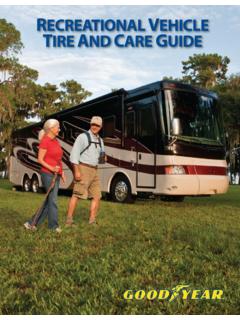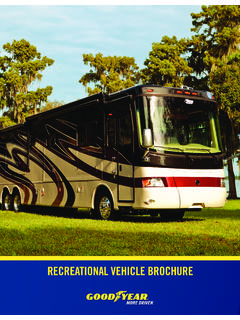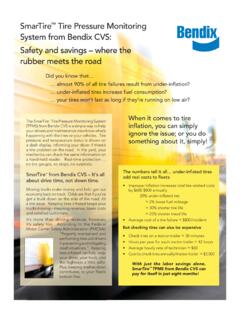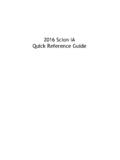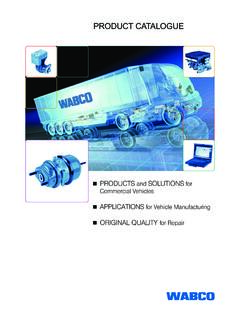Transcription of RV TIRE MAINTENANCE AND INFLATION TIPS
1 RV TIRE MAINTENANCE AND INFLATION tips PROTECTING YOUR INVESTMENT ON THE ROADM aintaining proper air pressure in RV tires is the best way to enhance tread life and overall performance. Improper tire infl ation can reduce traction, fuel economy, load-carrying capability and tread life and cause permanent structural damage to the tire, including a tire failure. A moment of your time can help ensure you get the most enjoyment from your RV and its tires. DID YOU KNOW? The pressure in a hot tire can be 10 to 15 psi higher than in a cold TO CHECK INFLATION pressure You should always check your infl ation pressure at least once a month while storing your RV, as well as before and after long or short road trips. This will help you identify a possible slow leak that could catch you off guard when out on a long trip. If your tire pressure is below proper levels, infl ate your tires to the pressure recommended by the vehicle manufacturer.
2 CHECKING YOUR TIRE INFLATION Remember to let your RV tires cool before taking a tire pressure reading. Even slight fl uctuations in temperature can impact pressure levels. Tires that have lost more than 20% of their recommended pressure are considered fl at and should be removed from service and inspected. Have all luggage, equipment, fl uids (fuel, water, gas, etc.) and accessories in your RV before weighing to determine the total gross vehicle weight Never exceed the vehicle load capacity found in the RV owner s manual or the maximum load molded on the tire sidewall Weigh each wheel position to ensure one side of the RV is not overloaded Use a quality truck tire gauge with a dual-angled head Make sure to check the infl ation pressure of outer and inner tires to ensure even load distribution Adjust the infl ation pressure on all tires to match the tire that is carrying the heaviest load All tires on the same axle should have the same infl ation pressure to support the heaviest load Use proper sealing metal valve caps or quality fl ow-through valve caps.
3 Which are available at your authorized Goodyear Commercial Tire DealerNOT ALL RVs ARE BUILT THE SAME The recommended infl ation pressures for your tires are indicated on the certifi cation label of your RV or in your owner s manual. Because RVs can be loaded with diff erent confi gurations, the load on each tire may vary. For this reason, refer to your owner s manual or the load/infl ation information that can be found at when adjusting the pressure of each individual tire, or consult your Goodyear Commercial Tire Dealer. Never reduce the recommended tire pressure to have a softer ride. This will likely damage the tire and could result in a sudden loss of air and erratic driving For every one psi a tire is underinfl ated, you will lose approximately 20-30 pounds of load-carrying capacity per tire (varies based on tire size and single- or dual-tire application)BALANCING THE LOAD Luggage, fl uids and other cargo can aff ect the weight distribution of your RV.
4 It s important not to overload a particular side or axle on your RV. Even Weight Distribution Helps: Enhance handling and fuel economy Improve treadwear Maintain optimal braking ability Reduce excessive wear of RV components INSPECTING THE CONDITION OF YOUR TIRESIt s important to check every tire on your RV on a regular basis. Rotate the tires completely and make sure there are no nails or other objects penetrating any of the tires. If you fi nd something, do not drive the RV until you have your tires inspected by an authorized Goodyear Commercial Tire Dealer. Immediately replace any tires if necessary. Tire Inspection tips : Check every tire for signs of sidewall cracking Avoid using sidewall treatments or dressings, which can actually accelerate cracking Look for worn tires that can decrease traction, reduce handling and are more susceptible to punctures Replace tires before they reach the tread depth indicator You can fi nd tread depth indicators between the tread grooves at locations marked on the sidewall with little triangles MONITORING TIRES WITH TPMSYou can install a TPMS (Tire pressure Monitoring System) in your RV to electronically monitor the air pressure inside the tires.
5 A TPMS can help you identify a possible slow leak and allow you to take the necessary precautions to repair it before the tire loses more pressure . There are many diff erent brands of TPMS available at diff erent price points. However, you still need to check your tire s infl ation pressure as specifi ed in this guide, regardless of whether or not you have a TPMS installed. Talk to your Goodyear Commercial Tire Dealer or other qualifi ed RV service center to determine which option is the best fi t for your RV. STORING YOUR RV AND TIRES When storing an RV (or spare RV tires), avoid locations that experience frequent and extreme temperature changes. Do not keep tires next to radiators or other sources of heat. Avoid storing tires near electric motors, which can produce high concentrations of ozone that can accelerate tire cracking. Tires subjected to these conditions will change more quickly than those stored in a cool, constant environment.
6 NEED ASSISTANCE? When buying RV tires, be sure to select tires that meet the load capacity and usage requirements of your RV. Remember to account for the total load you expect to carry. You can always ask your Goodyear Commercial Tire Dealer for assistance in (1) selecting the proper tires for your RV, (2) applying the correct infl ation pressure and (3) properly balancing your you encounter a fl at tire on your RV, do NOT attempt to repair it on your own. Contact a Goodyear Commercial Tire Dealer immediately by calling or visiting Complete RV tire, selection, care and MAINTENANCE information is available at TIRE INFLATION PRESSURES The recommended infl ation pressures for your RV tires are indicated on the certifi cation label of your RV or in your owner s manual. Because RVs can be loaded with diff erent confi gurations, the load on each tire may vary. For assistance in determining the proper infl ation pressure for your RV tires, ask your Goodyear Commercial Tire Dealer, visit or refer to your owner s manual.
7 Complete RV tire safety, selection, care and MAINTENANCE information is available at TIRE INFLATION QUICK tips Always check your tires infl ation pressure before and after trips, and at least once a month while storing your RV. Remember to let your RV tires cool before taking a tire pressure reading Have all luggage, equipment, fl uids (fuel, water, gas, etc.) and accessories in your RV before weighing to determine the total gross vehicle weight Never exceed the vehicle load capacity found in the RV owner s manual or the maximum load molded on the tire sidewall Make sure to check the infl ation pressure of outer and inner tires to ensure even load distribution Adjust the infl ation pressure on all tires to match the tire that is carrying the heaviest load All tires on the same axle should have the same infl ation pressure to support the heaviest loadIf you need assistance in determining your RV tire infl ation pressures, contact a Goodyear Commercial Tire Dealer by calling or visiting 2014 The Goodyear Tire & Rubber Company.
8 All rights reserved. 00-00-46437-11/141-866-353-3847 /
